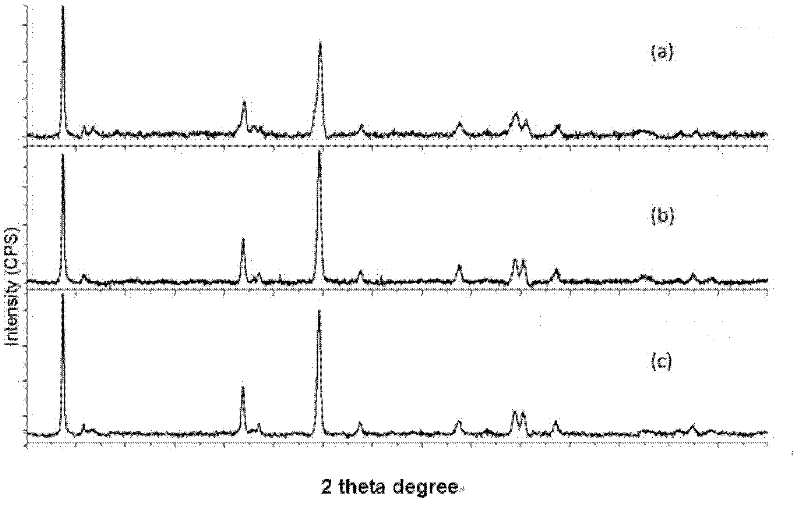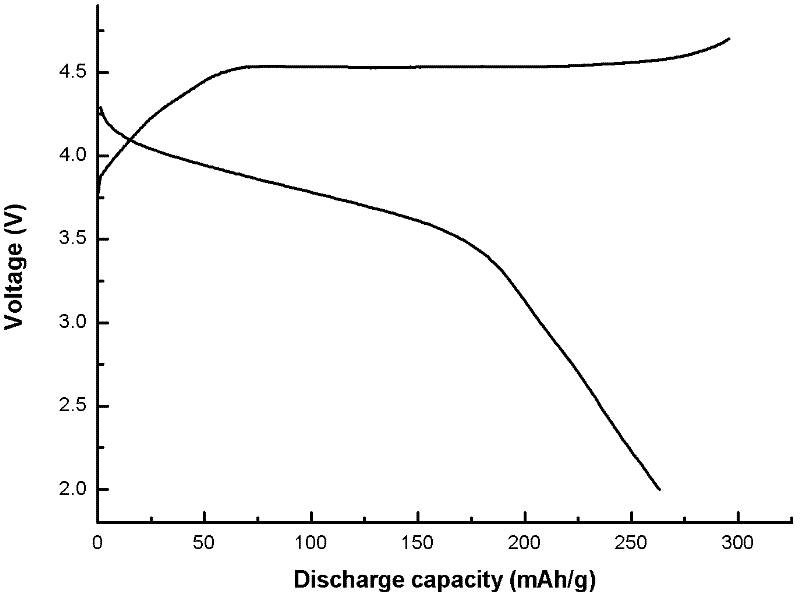Thermal polymerization preparation method of manganides solid solution positive material
A cathode material, thermal polymerization technology, applied in battery electrodes, electrical components, circuits, etc., can solve the problems of poor product performance consistency, unsatisfactory rate performance, large irreversible capacity, etc. Outstanding performance
- Summary
- Abstract
- Description
- Claims
- Application Information
AI Technical Summary
Problems solved by technology
Method used
Image
Examples
Embodiment 1
[0026] 1. Prepare 1L of citric acid and ethylene glycol solution, and the ratio of the two substances is 1:4.
[0027] 2. According to the molecular formula Li[Ni 0.35 Li 0.1 Mn 0.55 ]O 2 The proportions of Li, Ni, Mn in the lithium acetate, nickel acetate, and manganese acetate are weighed. The molar percentage of lithium, nickel, and manganese metal ions is 0.11:0.035:0.055. The metal salt is dissolved in deionized water to form a total metal ion. A mixed metal salt solution with a concentration of 0.5 mol / L.
[0028] 3. Add the solution in 2 to the mixed solution described in 1, adjust the pH of the solution to 5 with 0.5 mol / L concentration of ammonia, and stir vigorously at 80° C. for 2 hours until the metal salt is completely dissolved and gradually forms a gel.
[0029] 4. Take out the gel obtained in 3 and place it in a vacuum drying oven, and dry it at 140°C for 12 hours to form a block precursor.
[0030] 5. Put the precursor into a muffle furnace, heat it up to 450°C at a r...
Embodiment 2
[0033] 1. Prepare 1L of citric acid and ethylene glycol solution, and the ratio of the two substances is 1:4.
[0034] 2. According to the molecular formula Li[Ni 0.35 Li 0.1 Mn 0.55 ]O 2 The proportions of Li, Ni, Mn in the lithium acetate, nickel acetate, and manganese acetate are weighed. The molar percentage of lithium, nickel, and manganese metal ions is 0.11:0.035:0.055. The metal salt is dissolved in deionized water to form a total metal ion. A mixed metal salt solution with a concentration of 0.2mol / L.
[0035] 3. Add the solution in 2 to the mixed solution described in 1, adjust the pH of the solution to 5 with 0.5 mol / L concentration of ammonia, and stir vigorously at 80° C. for 2 hours until the metal salt is completely dissolved and gradually forms a gel.
[0036] 4. Take out the gel obtained in 3 and place it in a vacuum drying oven, and dry it at 140°C for 12 hours to form a block precursor.
[0037] 5. Put the precursor into a muffle furnace, heat it up to 450°C at a ra...
Embodiment 3
[0040] 1. Prepare 1L of citric acid and ethylene glycol solution, and the ratio of the two substances is 1:4.
[0041] 2. According to the molecular formula Li[Ni 0.35 Li 0.1 Mn 0.55 ]O 2 The ratio of Li, Ni, Mn in the lithium sulfate, nickel sulfate, and manganese sulfate are weighed. The mole percentage of lithium, nickel, and manganese metal ions is 0.11:0.035:0.055. The metal salt is dissolved in deionized water to form a total metal ion. A mixed metal salt solution with a concentration of 0.5mol / L.
[0042] 3. Add the solution in 2 to the mixed solution described in 1, adjust the pH of the solution to 5 with 0.5 mol / L concentration of ammonia, and stir vigorously at 80° C. for 2 hours until the metal salt is completely dissolved and gradually forms a gel.
[0043] 4. Take out the gel obtained in 3 and place it in a vacuum drying oven, and dry it at 140°C for 12 hours to form a block precursor.
[0044] 5. Put the precursor into a muffle furnace, heat it up to 450°C at a rate of 2...
PUM
 Login to View More
Login to View More Abstract
Description
Claims
Application Information
 Login to View More
Login to View More - R&D
- Intellectual Property
- Life Sciences
- Materials
- Tech Scout
- Unparalleled Data Quality
- Higher Quality Content
- 60% Fewer Hallucinations
Browse by: Latest US Patents, China's latest patents, Technical Efficacy Thesaurus, Application Domain, Technology Topic, Popular Technical Reports.
© 2025 PatSnap. All rights reserved.Legal|Privacy policy|Modern Slavery Act Transparency Statement|Sitemap|About US| Contact US: help@patsnap.com



